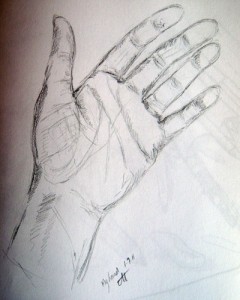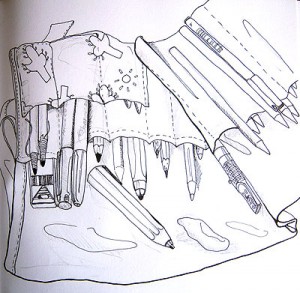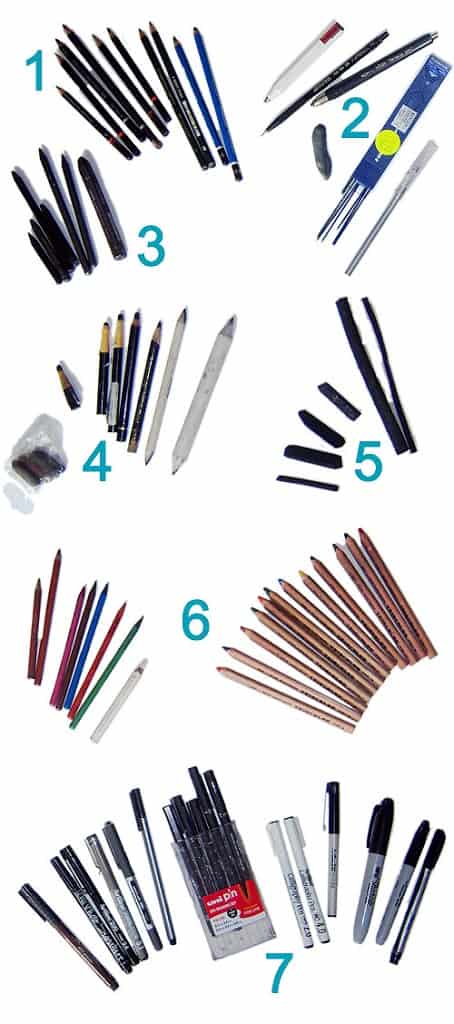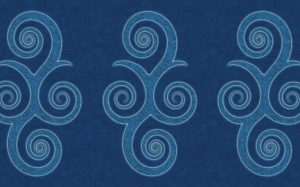On the subject of pens and drawing materials I thought it might be fun to show some of my favourite items and talk a little about their uses. Each artist has their favourite pens and materials, and their personal way of storing, using and combining them (a friend of mine recently said that she sees pens for artists as extensions of their hands – I really like that analogy).
The Materials
Below you’ll find a selection of the pens and drawing tools I use – happily laid out on a large white piece of paper before being snapped, I’ve added a number next to each group & explain how I use the materials below. The quality of this image doesn’t live up to the highly professional product shots I borrowed and included in my last post…, but hopefully it helps give some idea. If you are just getting into drawing then you may find something of use here… if you are an avid drawer you may favour completely different materials (which is great as we’re all different).
1. Pencils
I prefer to work with soft grade pencils – 2B is the ‘hardest’ grade I use – up to 9B for the darkest lines. Pencils are great on their own, to create a finished drawing – or to use as a sketch foundation for a drawing which I then finish off with pen & ink. Some of these pencils can be brushed with water to create a wash effect (a bit like watercolour or light ink wash).
2. Fixpencils, lead holders, lead, knife & soft rubber
I have put all these in one group as I tend to use them together. Lead holders are different from pencils in that they are refillable pencils – the holder, which is designed with comfort and use in mind, will generally last you a life-time (or slightly less depending on how tough you are on tools). Although referred to as lead holders, lead, and lead pencils; the word lead is misleading as NO pencils or sticks contain lead – they are made from pure graphite with a clay binding. I use an Xacto knife to sharpen both pencils and lead sticks, it is sharp and accurate and perfect for all shapes and sizes (as long as you’re careful…). The soft kneaded rubber (also known as knetgummi) is my favourite eraser, it doesn’t crumb, tear the paper or create a mess, instead it simply lifts or smudges the graphite (or charcoal) and can be used to both erase and shade parts of a drawing.

3. Graphite
I use graphite in the same way as pencils, with the larger fatter sticks being more suited to larger drawings; one great aspect of graphite sticks is that you can lay them on their side to create wide strokes. Like pencils, graphite sticks come in different grades though they tend to be on the softer side of the scale (2B – 9B).
4. Conté and stomps
Conté sticks are a mixture of compressed charcoal, graphite and wax. The ones in peel-away paper casings are also suitable for drawing on lithography stone (the fatter the crayon or stick is, the darker the end result on the print will be). I use conté in a similar way to charcoal – it produces nice dark tones and tends to hold together a little better than pure charcoal, which makes it perfect for detail. Paper stomps are useful for shading, and smudging areas of a drawing (although I tend to end up using my fingers as well).
5. Charcoal
I must confess I love charcoal – for all its messiness it is a wonderful medium for producing drawings rich in contrast. I use Willow charcoal (produced from willow tree twigs) and also a soft form of compressed charcoal which produced a very black velvety tone.
6. Coloured pencils and graphite sticks
Coloured pencils come in all shapes and sizes ranging from the hard (light in colour) to the softer denser versions, and also the watercolour variety, which can be used to produce wash effects in a drawing. My favourite coloured pencils are soft and bright in colour; the graphite sticks and tricolor pencils by Koh-I Nor above, are lovely to work with.

7. Ink pens & markers
I use ink pens & markers on their own for sketches and line drawings and also to finish off sketched pencil drawings. As with all tools there are favourites to be found in this group as well; ink colour and quality varies depending on the maker (black is often not a pure black, but will lean towards blue, green, purple or brown) – I tend to go for waterproof, permanent ink in pens as it tends to produce blacker lines and is supposed to stand the test of time more than soluble varieties. It also dries quicker, which makes it easier to work with.

Annette :)



